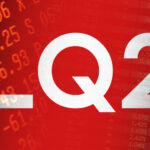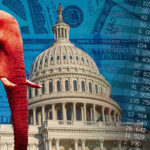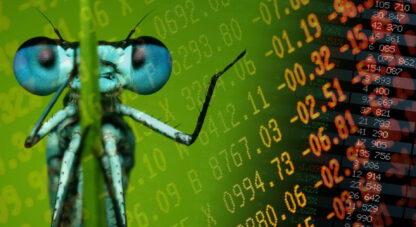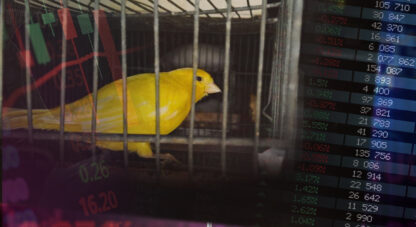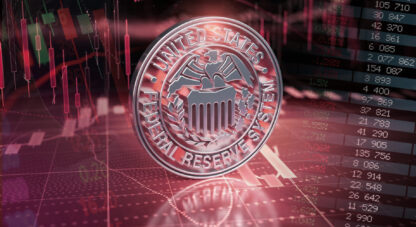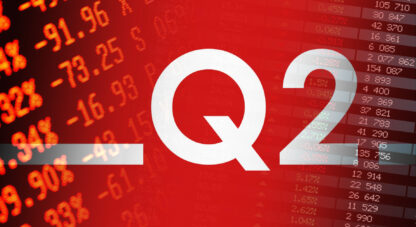The global central bank community has been wrong on inflation. Their analysis lacked objectivity and analytical vigor. Groupthink. Flatfooted. That policymakers would so misjudge on something fundamental to monetary management is a major blow to credibility. And not to be on guard after unleashing trillions of new “money” is inexcusable. The inevitable serious fallout seemed to begin this week.
The global inflation problem has been obvious for months, though central bankers were loath to upset the markets. They were hoping it would resolve itself. In the pinnacle of “asymmetric” monetary policy, central bankers have been eager to move immediately with previously unimaginable monetary stimulus. Yet fear of market disruption compelled the most gradual approach to the unwinding of stimulus measures (i.e. the Fed and ECB continue today with QE programs).
Monetary inflation went much too far – then ran amuck. Over the past two years, unprecedented monetary stimulus pushed speculative asset Bubbles into historic manias. It also stoked inflationary dynamics that had already attained significant momentum from years of loose finance. Focused on market fragilities, central bankers were willing to dismiss inflation risk and stick with their newfound gradualist doctrine. And gradualism played an integral role in promoting only greater market excess, while ensuring dangerously deep-rooted inflation.
Following the ECB’s December 16th meeting, Christine Lagarde stated that “monetary accommodation is still needed for inflation to stabilize at our 2% inflation target over the medium term,” adding that it was “highly unlikely” the ECB would begin raising rates until at least 2023.
February 2 – Reuters (Balazs Koranyi and Francesco Canepa): “Euro zone inflation rose to a new record high last month, defying expectations for a big drop and piling pressure on the European Central Bank to finally admit that price growth is not as temporary and benign as it has long predicted. Inflation across the 19 countries that share the euro picked up to 5.1% in January from 5% in December, far outpacing expectations… for a drop to 4.4%… The reading reflected soaring energy prices as expected but unprocessed food inflation also jumped more than 5%, a potential source of political pressure on the ECB as fuel and food prices impact ordinary voters quickly. Inflation is now more than twice the ECB’s 2% target.”
It’s worth noting that German inflation was a stronger-than-expected 5.1% annualized during January. Spain reported CPI of 6.1%, Italy 5.3%, Austria 5.1%, and France 3.3%. They were left with no alternative. Christine Lagarde and the ECB had to pivot from an embarrassingly indefensible position.
February 3 – Financial Times (Martin Arnold and Tommy Stubbington): “Christine Lagarde refused to rule out raising interest rates this year in response to the European Central Bank’s ‘unanimous concern’ about soaring prices, fuelling increased investor bets that it will raise borrowing costs several times in 2022. The ECB president said inflation risks were ‘tilted to the upside’… She backed away from earlier comments playing down the chances of the bank raising rates in 2022 because of ‘the situation having changed’ and said it was ‘getting much closer’ to hitting its target on inflation. Lagarde said there was ‘consensus’ among ECB policymakers on its decision to keep rates unchanged and to pursue a ‘step-by-step” reduction in bond purchases this year. But a person familiar with the council said ‘one or two’ of its members had called for an immediate tightening of policy.”
In our age of levered global speculative finance, there are outsize costs associated with policy mistakes: too much excess-fueling leverage leads eventually to destabilizing de-risking/deleveraging dynamics. For a while now, periphery European debt markets have been at the epicenter of epic policy-induced market distortions. It was a bloody week.
Italian 10-year yields surged 46 bps this week to 1.75%, the high since May 2020. Greek yields jumped 40 bps to 2.25%, the highest level since April 2020, with yields already up 94 bps y-t-d. Yields surged 35 bps in Portugal (0.97%) and 34 bps in Spain (1.04%). French yields jumped 28 bps to 0.64% – the highest yield since January 2019. German yields rose 25 bps to a positive 0.21%, also the high since January 2019.
“Periphery” European debt (Italian and Greek in particular) have arguably been among the most mispriced sovereign bonds in the world. With Italy’s debt-to-GDP above 155% and Greece’s surpassing 200%, market repricing risk is extreme.
While markets are far from 2012, it’s worth recalling Europe’s “doom loop” dynamic of vulnerable European banks exposed to large “periphery” bond holdings. Curiously, European banks stocks were higher this week, with the STOXX 600 Bank Index’s 2.4% advance boosting y-t-d gains to 9.8%. Alarm, however, was apparent in European Credit. Not surprisingly, the major European banks jumped to the top of the CDS leaderboard for the week (i.e. UniCredit up 7 to 82bps). An index of European subordinated bank CDS jumped 10 to a 15-month high of 138 bps (traded as high as 144bps intraday Friday). An index of European high-yield bond CDS jumped 29 to a 15-month high 315 bps.
It wasn’t only the ECB and European bond yields that shook the world of finance this week. The Bank of England raised rates 25 bps in consecutive meetings, with four of nine committee members (apparently more concerned with inflation risk and BOE credibility than market reaction) pressing for a 50 bps hike. Markets are now pricing in short rates of 1.50% by September. UK 10-year yields jumped 17 bps this week to a 26-month high 1.41%. Europe this week became a full-fledged active participant of Global Crisis Dynamics.
February 4 – Reuters (Marc Jones): “The world’s top central banks are about to embark on ‘the largest quantitative tightening in history’, analysts at Morgan Stanley said…, estimating that $2.2 trillion worth of support would disappear over the next 12 months. A surge in global inflation is forcing the U.S. Federal Reserve, European Central Bank, Bank of Japan and Bank of England to reel in the support measures used during the coronavirus pandemic.”
Markets occasionally offer subtle hints. Of late, they’re coming persistently and not so subtly. Thursday trading is a case in point. Besides Lagarde’s awkward pivot and the Bank of England’s urgency, Facebook (“Meta Platforms”) dropped an earnings mega bombshell. Priced for endless growth, investors were slammed by the reality of a hyper-competitive environment with major threats to the company’s business model. Welcome to the technology mania aftermath, where speculative Bubbles and resulting ultra-loose finance ensured massive over-investment and “arm’s race” dynamics.
February 3 – Bloomberg (Thyagaraju Adinarayan and Jan-Patrick Barnert): “Meta Platforms Inc.’s one-day crash now ranks as the worst in stock-market history. The Facebook parent plunged 26% Thursday on the back of woeful earnings results, and erased about $251.3 billion in market value. That’s the biggest wipeout in market value for any U.S. company ever.”
That was Thursday. What about Friday?
February 3 – Bloomberg (Jeran Wittenstein and Tom Contiliano): “Amazon.com Inc. gave the market back what Meta Platforms Inc. took away — or at least a big chunk of it. The e-commerce giant’s shares surged 14% on Friday, adding about $191 billion in market value, after investors cheered its fourth-quarter earnings report. The advance was the biggest single-day gain in U.S. stock market history…”
Markets these days couldn’t be more unstable or, seemingly, accident prone. That $251 billion of perceived wealth in one company’s stock can instantly evaporate into thin air should give pause to market participants of all stripes. And it should be unnerving that perceived wealth in stocks and bonds now shows a tendency toward simultaneous spontaneous combustion.
Meanwhile, major U.S. stock indices all posted solid gains for the week. Between the rally and the retreating VIX, the market is working its magic to destroy the value of put options purchased recently to hedge market risk. It’s now only two weeks until February options expiration.
And while stocks reversed higher, I doubt many sophisticated market operators will enjoy a relaxing weekend. Things seem to turn more ominous by the week. In particular, the nexus between surging bond yields, tightening financial conditions, and the faltering tech Bubble was on full display Thursday. Investment-grade CDS closed the week up three bps to a 15-month high 64 bps – with the majority of the gain coming on Thursday. High-yields CDS rose 13 this week to a 15-month high 356 bps – gaining 11 bps during Thursday trading.
Financial conditions have begun to tighten. They’re not, however, tightening quickly enough to restrain surging commodities prices. WTI crude jumped another $5.49 this week to $92.31, increasing early-2022 gains to 23%. The Bloomberg Commodity Index’s 2.3% advance boosted y-t-d gains to 10.5%.
Markets are now confronting the problematic dynamic of surging Treasury and sovereign yields, along with widening corporate Credit spreads and rising CDS prices. Ten-year Treasury yields jumped 14 bps this week to a more than two-year high 1.91% (2-yr yields up 15bps to 1.31%). The Bloomberg Long Corporate spread index gained three bps this week to a 14-month high 1.49%. Benchmark MBS yields surged another 19 bps (up 67bps y-t-d!) to 2.73%, the high since the March 2020 crisis spike. All indications point toward mounting pressures on levered players to rein in some risk and leverage.
The market environment has changed – A Changing World. Unfolding deleveraging will place mounting pressure on various faltering Bubbles. And no sector today appears more vulnerable than the expansive technology super-industry. For years, a tsunami of speculative finance fueled the loosest financial conditions ever, replete with record corporate debt sales, stock issuance, IPOs, SPACs, M&A, private-equity, venture capital and such.
The vast technology universe – the usual computer and communication technologies joined by big data and the cloud, AI, quantum computing, blockchain, robotic automation, EV and autonomous vehicles, solar and green energy, Internet of Things, 5G, virtual reality, wearable tech, 3D printing, cybersecurity, drones, biomedical and telehealth, and on and on. It’s been such an extended period of overabundance of cheap finance available for just about anything.
The underlying economics of an enterprise have been virtually inconsequential. The upshot has been a proliferation of tens of thousands of loss-making ventures whose existence depends on easily accessible finance. In Austrian economic terms, it’s a “Bubble economy” structure that has been feasting on ever larger amounts of cheap and indiscriminate money and Credit.
The significantly tighter financial conditions necessary to contain inflationary dynamics place the aged “tech” Bubble in peril. And the rapidly rising risk of faltering market and industry Bubbles will pressure a vulnerable corporate debt market. High-yield bond funds suffered outflows of $4.0 billion this past week. At $6.5 billion, January was a record month for high-yield fund outflows. Resilient throughout 2021, the junk bond market appears increasingly susceptible. We’ve witnessed the first crack in the equities Bubble. Things turn more serious when the next leg of instability includes the interplay of a faltering corporate debt market.
And within the “A Changing World” theme, I would be remiss for not highlighting this era’s Olympic spirit.
“There is no limit to what we can achieve when we work together – for peace, for human rights, and for healthy lives and wellbeing for everyone.” UN Secretary António Guterres, February 4th, 2022
February 4 – Reuters (Andrew Osborn and Mark Trevelyan): “China and Russia proclaimed a deep strategic partnership on Friday to balance what they portrayed as the malign global influence of the United States as China’s President Xi Jinping hosted Russia’s Vladimir Putin on the opening day of the Beijing Winter Olympics. In a joint statement, the two countries affirmed that their new relationship was superior to any political or military alliance of the Cold War era. ‘Friendship between the two States has no limits, there are no ‘forbidden’ areas of cooperation,’ they declared, announcing plans to collaborate in a host of areas including space, climate change, artificial intelligence and control of the Internet. The agreement marked the most detailed and assertive statement of Russian and Chinese resolve to work together – and against the United States – to build a new international order based on their own interpretations of human rights and democracy.”
For the Week:
The S&P500 rallied 1.5% (down 5.6% y-t-d), and the Dow recovered 1.0% (down 3.4%). The Utilities gained 0.9% (down 5.0%). The Banks jumped 4.2% (up 5.9%), and the Broker/Dealers surged 5.7% (up 1.6%). The Transports rose 1.1% (down 7.7%). The S&P 400 Midcaps rallied 1.7% (down 7.7%), and the small cap Russell 2000 recovered 1.7% (down 10.8%). The Nasdaq100 advanced 1.7% (down 10.0%). The Semiconductors jumped 4.5% (down 12.5%). The Biotechs rose 2.7% (down 7.9%). With bullion rallying $17, the HUI gold index recovered 2.5% (down 4.9%).
Three-month Treasury bill rates ended the week at 0.22%. Two-year government yields rose 15 bps to 1.31% (up 58bps y-t-d). Five-year T-note yields jumped 16 bps to 1.77% (up 51bps). Ten-year Treasury yields gained 14 bps to 1.91% (up 40bps). Long bond yields rose 14 bps to 2.21% (up 31bps). Benchmark Fannie Mae MBS yields surged 19 bps to a 26-month high 2.74% (up 67bps).
Greek 10-year yields surged 40 bps to 2.25% (up 94bps y-t-d). Ten-year Portuguese yields jumped 35 bps to 0.97% (up 50bps). Italian 10-year yields spiked 46 bps higher to 1.75% (up 57bps). Spain’s 10-year yields rose 34 bps to 1.04% (up 47bps). German bund yields jumped 25 bps to 0.21% (up 38bps). French yields surged 28bps to 0.65% (up 45bps). The French to German 10-year bond spread widened about three to 44 bps. U.K. 10-year gilt yields rose 17 bps to 1.41% (up 44bps). U.K.’s FTSE equities index increased 0.7% (up 1.8% y-t-d).
Japan’s Nikkei Equities Index rallied 2.7% (down 4.7% y-t-d). Japanese 10-year “JGB” yields gained three bps to 0.20% (up 13bps y-t-d). France’s CAC40 slipped 0.2% (down 2.8%). The German DAX equities index fell 1.4% (down 4.9%). Spain’s IBEX 35 equities index declined 0.2% (down 1.4%). Italy’s FTSE MIB index was little changed (down 2.7%). EM equities were mostly higher. Brazil’s Bovespa index added 0.3% (up 7.1%), and Mexico’s Bolsa gained 1.2% (down 3.8%). South Korea’s Kospi index recovered 3.3% (down 7.6%). India’s Sensex equities index jumped 2.5% (up 0.7%). China’s Shanghai Exchange was closed for holiday (down 7.6%). Turkey’s Borsa Istanbul National 100 index fell 2.0% (up 4.6%). Russia’s MICEX equities index declined 0.5% (down 8.4%).
Investment-grade bond funds saw outflows of $70 million, and junk bond funds posted negative flows of $4.043 billion (from Lipper).
Federal Reserve Credit last week declined $11.0bn to $8.828 TN. Over the past 125 weeks, Fed Credit expanded $5.101 TN, or 137%. Fed Credit inflated $6.017 Trillion, or 214%, over the past 482 weeks. Elsewhere, Fed holdings for foreign owners of Treasury, Agency Debt last week declined $0.3bn to $3.458 TN. “Custody holdings” were down $73.4bn, or 2.1%, y-o-y.
Total money market fund assets fell $17.5bn to $4.628 TN. Total money funds increased $317bn y-o-y, or 7.3%.
Total Commercial Paper slipped $1.8bn to $1.023 TN. CP was down $34.2bn, or 3.2%, over the past year.
Freddie Mac 30-year fixed mortgage rates were unchanged at 3.55% (up 82bps y-o-y). Fifteen-year rates declined three bps to 2.77% (up 56bps). Five-year hybrid ARM rates added a basis point to 2.71% (down 7bps). Bankrate’s survey of jumbo mortgage borrowing costs had 30-year fixed rates down three bps to 3.75% (up 88bps).
Currency Watch:
For the week, the U.S. Dollar Index dropped 1.8% to 95.49 (down 0.2% y-t-d). For the week on the upside, the Swedish krona increased 3.1%, the euro 2.7%, the Norwegian krone 2.1%, the New Zealand dollar 1.3%, the Australian dollar 1.2%, the Brazilian real 1.1%, the British pound 1.0%, the South African rand 0.9%, the South Korean won 0.7%, the Singapore dollar 0.7%, the Mexican peso 0.6%, the Swiss franc 0.5% and the Canadian dollar 0.1%. The Chinese renminbi was unchanged versus the dollar (down 0.08% y-t-d).
Commodities Watch:
February 2 – Bloomberg (Grant Smith, Julian Lee and Salma El Wardany): “OPEC and its allies are expected to approve another modest supply increase on Wednesday, yet new data showed the cartel still struggling to deliver on its pledges, a failure that has fanned a rally in global crude prices. The 23-nation coalition led by Saudi Arabia and Russia will likely rubber-stamp the nominal revival of 400,000 barrels a day for March… But members of the Organization of Petroleum Exporting Countries barely increased supplies last month amid under-investment and militia unrest…, while government data indicated Moscow was also unable to hit its target.”
February 2 – Bloomberg (Anna Shiryaevskaya and Isis Almeida): “Energy-rich countries from Qatar to Azerbaijan have all pledged emergency gas supplies to Europe, but the region is quickly figuring out it can’t replace top supplier Russia. Ongoing tensions over Ukraine and the threat of a potential conflict interrupting energy flows to Europe have overshadowed the continent’s gas market in recent weeks, causing volatile price swings. War could interfere with the massive volumes that Russia sends to the continent, about a third of which come through Ukraine. To mitigate the risk of supply disruption, the European Union is speaking with major producers, seeking partnerships and even potential fuel swaps with Asia, where the market is twice the size of the bloc’s.”
The Bloomberg Commodities Index jumped 2.3% (up 10.5% y-t-d). Spot Gold gained 0.9% to $1,808 (down 1.1%). Silver increased 0.2% to $22.52 (down 3.4%). WTI crude surged $5.49 to $92.31 (up 23%). Gasoline jumped 5.4% (up 20%), while Natural Gas declined 1.4% (up 23%). Copper rallied 4.1% (up 1%). Wheat dropped 2.9% (down 1%), and Corn fell 2.4% (up 5%). Bitcoin recovered $2,937, or 7.8%, this week to $40.738 (down 12%).
Coronavirus Watch:
January 31 – Wall Street Journal (Jon Kamp, Jennifer Levitz, Brianna Abbott, and Paul Overberg): “Two years into the Covid-19 pandemic, America’s death toll is closing in on one million. Federal authorities estimate that 987,456 more people have died since early 2020 than would have otherwise been expected, based on long-term trends. People killed by coronavirus infections account for the overwhelming majority of cases. Thousands more died from derivative causes, like disruptions in their healthcare and a spike in overdoses. Covid-19 has left the same proportion of the population dead—about 0.3%—as did World War II, and in less time. Unlike the 1918 flu pandemic or major wars, which hit younger people, Covid-19 has been particularly hard on vulnerable seniors. It has also killed thousands of front-line workers and disproportionately affected minority populations.”
February 2 – Financial Times (Oliver Barnes, Ella Hollowood and Donato Paolo Mancini and Primrose Riordan): “Scientists who track coronavirus mutations are closely monitoring an uptick in cases of an Omicron sub-variant named BA.2, just as countries were beginning to hope the worst of the latest wave of coronavirus infections had passed. The strain has been detected in 57 countries…, and now accounts for about a tenth of Sars-Cov-2 genome sequences uploaded to the global repository Gisaid. The original version of Omicron, designated as BA.1, is still responsible for most cases. Nevertheless, BA.2 has become the dominant variant in Denmark, India and South Africa.”
February 1 – Reuters (Nikolaj Skydsgaard): “The BA.2 subvariant of the Omicron coronavirus variant, which has quickly taken over in Denmark, is more transmissible than the more common BA.1 and more able to infect vaccinated people, a Danish study has found. The study, which analysed coronavirus infections in more than 8,500 Danish households between December and January, found that people infected with the BA.2 subvariant were roughly 33% more likely to infect others, compared to those infected with BA.1.”
Covid Disruption Watch:
January 29 – Reuters (Stella Qiu and Ryan Woo): “China’s factory activity contracted at the sharpest rate in 23 months in January, underscoring the huge economic costs from the country’s zero-COVID approach as surging cases and tough containment measures weighed on output and demand… The Caixin/Markit Manufacturing Purchasing Managers’ Index (PMI) fell to 49.1 in January – its lowest level since February 2020, when the economy was still suffering from country-wide COVID-19 lockdowns in the early days of the pandemic.”
Market Mania Watch:
January 31 – Bloomberg (Michael MacKenzie and Ye Xie): “A bedrock of long-term investing, a portfolio split 60/40 between equities and high-quality bonds, posted its worst monthly slide since the market meltdown in the early days of the pandemic. Both equities and bond prices dropped sharply in January as markets priced in a faster pace of interest-rate tightening during 2022 from the Federal Reserve… The Bloomberg 60/40 index lost 4.2% in January, reflecting a decline of 5.6% for large cap equities and a loss of 2.2% for the Bloomberg U.S. Aggregate bond index. That’s the worst showing since a slump of 7.7% in March 2020…”
February 1 – Wall Street Journal (Alexander Osipovich): “Brokerages serving individual investors received a windfall last year for selling their customers’ order flow to electronic trading firms, even as the practice faced increasing scrutiny from regulators. The dozen largest U.S. brokerages earned a combined $3.8 billion for selling their customers’ stock and options orders last year, up 33% from 2020… Behind the boom was the groundswell of activity by individual investors… As more Americans opened brokerage accounts and swarmed into meme stocks and options, their brokers reaped more payment for order flow…”
February 1 – Bloomberg (Olivia Raimonde): “U.S. junk bonds just posted their worst start to a year ever… The Bloomberg U.S. Corporate High Yield Bond Index lost 2.73% last month on a total return basis, the biggest January decline on record and the worst month of any kind since the pandemic rocked markets in March 2020… And, to be sure, junk did have a better January than the 3.37% plunge experienced by U.S. high-grade debt. But that’s little comfort to high-yield investors now eyeing substantial portfolio losses.”
January 30 – Bloomberg (Julia Fioretti, Swetha Gopinath and Pei Li): “Initial public offerings have gotten off to a rough start of the year. Globally, $26.7 billion worth of IPOs have priced, marking a 60% drop from the same period a year earlier. Now, pulled deals are piling up under pressure from roiling markets.”
January 31 – Reuters (Davide Barbuscia): “U.S. public pension funds will likely have to switch to more aggressive investment strategies in the coming years to fill funding gaps despite assets held by sovereign investors having grown to record levels amid the 2021 equity market boom, a new report said. On average, the difference between assets and liabilities at U.S. public pension funds, known as the ‘funded ratio,’ remains ‘unsatisfactory’ at less than 75%, sovereign investor specialist Global SWF said… To boost returns, many will likely have to focus on alternative assets, including private equity and private credit, Diego Lopez at Global SWF told Reuters. ‘Certain pockets of real assets including logistics properties and infrastructure may also benefit from increased interest, and hedge funds will continue to be an important part of US [public pension funds’] portfolios.’ Assets held by sovereign wealth and public pension funds globally rose to a record $31.9 trillion in 2021…”
Market Instability Watch:
February 1 – Financial Times (Madison Darbyshire and Philip Stafford): “Investors are turning to derivatives to make supercharged bets on the US equities market, highlighting how the pandemic has left a lasting mark on Wall Street even as the rally in speculative shares fizzles. Trading volumes in options… have jumped this year, in an acceleration of a trend that began in the early days of the pandemic. Turnover at the main US equity derivatives clearing house, OCC, hit records on two consecutive days last month, exceeding 63mn contracts on both occasions. The average daily volume in January was 44.9mn contracts, compared with 39.4mn last year. The sharp rise underscores how the US options market has boomed over the past two years… OCC last year handled 9.9bn options, up almost a third on the previous year and double 2019’s total, which was also a record. ‘The options market has meaningfully changed in the past two years,’ said Thomas Peterffy, founder and chair of Interactive Brokers, a retail brokerage that handles a tenth of the US options market volume. Options volumes have doubled on the brokerage since the start of 2020.”
January 31 – Bloomberg (Lu Wang and Cristin Flanagan): “Two days of big stock rallies have investors wondering: Is the new year’s selloff over? Maybe, but a couple researchers are pointing to below-the-surface dynamics that may be exaggerating moves and leaving investors exposed to more volatility. At Goldman Sachs…, strategists including Rocky Fishman found that the market’s ability to absorb orders worsened rapidly during last week’s turmoil. Liquidity evaporated so much that a measure based on the bid-ask spread of S&P 500 futures widened to levels not seen since the 2020 pandemic crash. Over at JPMorgan…, strategists led by Marko Kolanovic observed a similar deterioration in liquidity, and noted that options dealers who buy or sell stocks to hedge their derivatives holdings are now in a ‘negative gamma’ position that requires them lean into existing market trends in a big way.”
February 1 – Bloomberg (Sam Potter): “The world’s biggest exchange-traded fund posted its worst monthly outflow in its near three-decade history with investors selling the Monday stock rebound en masse. The $407 billion SPDR S&P 500 ETF Trust, known by its ticker SPY, in January saw its biggest redemption since launching in 1993…, underscoring weeks of turmoil in U.S. large-cap companies.”
February 1 – Bloomberg (Alex Harris and Edward Bolingbroke): “A reduction in the size of the Federal Reserve’s balance sheet could hurt liquidity within the Treasury market, boost volatility and affect how different parts of the U.S. rates market are valued relative to one another, according to Goldman Sachs… The call by Goldman strategists including Praveen Korapaty follows remarks from Citigroup Inc. strategists, who said… the process of so-called quantitative tightening — which is widely expected to follow on the heels of the central bank’s first interest rate increases later this year — could spark a return of arbitrage opportunities for traders within U.S. interest-rate markets.”
February 2 – CNBC (Diana Olick): “Mortgage rates continued to surge higher last week, and that brought borrowers out of the woodwork, looking to refinance… Mortgage applications to refinance a home loan jumped 18% week to week, seasonally adjusted. Volume was still 50% lower than the same week one year ago… Mortgage applications to purchase a home increased 4% for the week but were 7% lower than the same week one year ago.”
January 31 – Bloomberg (Edward Bolingbroke): “A money-making strategy formerly popular among hedge funds stands to make a comeback as the Federal Reserve plots to shrink its footprint in the U.S. Treasury market. The strategy involves taking leveraged positions in Treasury notes and bonds in order to exploit price differences with the corresponding futures contracts. These so-called basis trades backfired during the March 2020 liquidity crisis, when the normal relationships between cash and futures broke down.”
February 4 – Bloomberg (Greg Ritchie, Garfield Reynolds and Enda Curran): “The world’s enormous pool of negative-yielding debt shrank by a record 20% in just a day, signaling that negative yields might be a thing of the past if ever-bolder bets on policy normalization pay out. In both Germany and Japan, the world’s major bastions of negative rates, five-year yields climbed above zero on Friday for the first time in years… They were once part of a pile of such debt, which has dwindled to $6.1 trillion, a three-year low.”
January 31 – Bloomberg (Liz McCormick): “The U.S. Treasury boosted its estimate of federal borrowing needs for the three months through March after entering the quarter with a cash pile that was run down by congressional delays in lifting the government’s debt limit. The Treasury’s new projections…, incorporate last month’s move by lawmakers to increase the debt ceiling by an amount intended to last until early next year. U.S. debt managers now expect to borrow $729 billion in the January-through-March period, about $254 billion more than the $476 billion in net marketable debt issuance it anticipated in November.”
Inflation Watch:
February 1 – New York Times (Peter S. Goodman): “With the havoc at ports showing no signs of abating and prices for a vast array of goods still rising, the world is absorbing a troubling realization: Time alone will not solve the Great Supply Chain Disruption. It will require investment, technology and a refashioning of the incentives at play across global business. It will take more ships, additional warehouses and an influx of truck drivers, none of which can be conjured quickly or cheaply. Many months, and perhaps years, are likely to transpire before the chaos subsides. ‘It’s unlikely to happen in 2022,’ said Phil Levy, chief economist at Flexport… ‘My crystal ball gets murky further out.’ For those who keep tabs on the global supply chain, the very concept of a return to normalcy has given way to a begrudging acceptance that a new normal may be unfolding.”
February 4 – Wall Street Journal (Charity L. Scott): “Everyday items, from grocery staples to home décor, are being priced more like airline tickets and gasoline, where the sticker prices can move frequently within hours or days. Retailers say the price moves are in response to rising production, labor and shipping costs, and continuing product shortages associated with the Covid-19 pandemic. The price changes are happening online as well as offline, especially among smaller retailers… ‘There have been more times than not where we’re almost just breaking even on products because of failure to be able to update the pricing,’ said Jeff Wachenfeld, who manages two True Value hardware stores on New York’s Long Island.”
February 1 – Bloomberg (Matthew Boesler): “If you’re a renter and you moved last year, you’re probably already paying more for shelter. If you didn’t, you may soon find yourself in a similar position, when your lease comes up for renewal. Outsize residential rent increases spreading from new leases to existing ones has been a distinct pattern in places like the Atlanta and Detroit metro areas, where rents rose in 2021 at the fastest pace in decades… In 2022, the pattern is set to become a nationwide phenomenon, as landlords recoup bargaining power they lost in the early part of the pandemic, when unemployment surged and governments responded by enacting eviction bans.”
January 31 – Bloomberg (Julia Fanzeres): “Oil had its biggest January gain in at least 30 years as robust demand outpaced fresh supply. The global benchmark settled above $91 a barrel, posting a 17% gain this month. The combination of booming demand, scratchy supply and dwindling stockpiles has helped crude soar this month, with top banks and oil companies saying prices may soon pass $100 a barrel.”
February 3 – Bloomberg (Megan Durisin): “Global food prices jumped toward a record last month, further adding to the surging cost of living for consumers. The United Nations’ index of prices rose 1.1% in January, pushed up by more expensive vegetable oils and dairy. The gauge is edging closer to 2011’s all-time high, and unfavorable weather for crops and the fallout from an energy crisis threaten to keep prices high going forward. Inflation has been running rampant across the globe…”
January 30 – Wall Street Journal (Joseph Walker): “Drugmakers raised list prices by an average of 6.6% in the first few weeks of this year on cancer, diabetes and other prescription medicines, sticking with more moderate increases while lawmakers scrutinize pricing practices. In all, about 150 drugmakers raised prices on 866 products in the U.S. through Jan. 20, according to… Rx Savings Solutions…”
January 31 – Bloomberg (Michael Hirtzer and Dominic Carey): “Drought is shrinking the American cattle herd, meaning consumers are unlikely to get relief from near-record beef prices anytime soon. Abnormally dry conditions last year in the northern U.S. Plains squeezed supplies of hay and feed for cattle, prompting some ranchers to sell to slaughterhouses animals usually held for breeding. Now, deepening drought in the southern part of the Plains — where most cattle in the U.S. are raised — could force another round of herd reductions later this year. ‘Drought is looming large,’ Derrell Peel, extension livestock marketing specialist at Oklahoma State University, said…”
February 3 – Bloomberg (Archie Hunter): “From Seoul to Seattle, the soaring cost of coffee beans is trickling into the cups of consumers. Some of the world’s biggest roasters and sellers of coffee are upping menu prices, having flagged that customers would be paying more as beans began to surge last year. Higher wages and other costs have also added to the rising charge for a daily cup, which is in turn increasing the inflationary pressures coursing through the global economy.”
Biden Administration Watch:
February 2 – Bloomberg (Jennifer Jacobs and Annmarie Hordern): “The Biden administration and European allies are searching the world for surplus natural gas to send to Europe in the event conflict erupts over Ukraine, including approaching China about its supplies, according to people familiar with the matter.”
February 1 – Washington Post (Eva Dou and Mary Ilyushina): “As Western governments scramble to predict Russian President Vladimir Putin’s intentions toward Ukraine, one of the countries with the clearest view may be China: Putin is expected to visit Beijing for Friday’s Winter Olympics Opening Ceremonies and for talks with his Chinese counterpart. Putin’s trip casts a spotlight on the China-Russia bond, which has deepened considerably in recent years… Both Beijing and Moscow see the partnership as key to countering a world dominated by the United States, as they share resources and technology and divide the attention of Western governments. ‘These two simultaneous challenges are much bigger than if the U.S. has to deal only with the China challenge or the Russia challenge,’ said Alexander Gabuev, a senior fellow at the Carnegie Moscow Center. ‘Joe Biden’s team is only human: They have 24 hours [in a day].’”
February 2 – Reuters (Steve Matthews): “China has failed to meet its commitments under a two-year ‘Phase 1’ trade deal that expired at the end of 2021, and discussions are continuing with Beijing on the matter, Deputy U.S. Trade Representative Sarah Bianchi said… ‘You know, it is really clear that the Chinese haven’t met their commitment in Phase 1. That’s something we’re trying to address,’ Bianchi told a virtual forum… Through November, China had met only about 60% of that goal, according to trade data compiled by Peterson Institute for International Economics senior fellow Chad Bown.”
Federal Reserve Watch:
February 2 – Bloomberg (Steve Matthews): “Federal Reserve officials have a message for investors ramping up 2022 interest-rate expectations: not so fast. None of six Fed officials speaking so far this week have backed the idea of a half-point rate increase in March, and the most aggressive, James Bullard, president of the St. Louis Fed, said five hikes — one more than every quarter — is ‘not too bad a bet.’ Ideally, the Fed prefers to go gradually, said Kansas City Fed chief Esther George, who’s another hawk. The measured calls contrast to Wall Street forecasts for as many as seven 2022 hikes, or even a half-point adjustment.”
January 31 – Bloomberg (Steve Matthews): “Federal Reserve Bank of Kansas City President Esther George said the central bank could take less aggressive actions in raising interest rates by shrinking the balance sheet more forcefully, which she said could help to avoid dangerous financial imbalances. ‘More aggressive action on the balance sheet could allow for a shallower path for the policy rate,’ George said… ‘Alternatively, combining a relatively steep path of rate increases with relatively modest reductions in the balance sheet could flatten the yield curve and distort incentives for private sector intermediation, especially for community banks, or risk greater economic and financial fragility by prompting reach-for-yield behavior from long-duration investors.’”
February 2 – Reuters (Ann Saphir and Jonnelle Marte): “U.S. President Joe Biden’s nominees to the Federal Reserve Board came out swinging against high inflation…, saying rising prices pose a threat to economic growth and stopping that trend is a paramount task for the central bank. ‘Our most important task is tackling inflation,’ Michigan State University economics professor Lisa Cook… said in her prepared remarks. The Fed must ‘ensure that inflation declines to levels consistent with its goals,’ wrote nominee Philip Jefferson, dean of faculty at Davidson College, while former Fed governor Sarah Bloom Raskin said reducing inflation must be a ‘top priority while we continue to sustain our economic recovery.’ The three Fed nominees had been widely seen as leaning dovish…”
January 30 – Bloomberg (Andrew Davis): “The Federal Reserve could opt to raise its benchmark rate by 50 bps if a more aggressive approach to taming inflation is needed, Raphael Bostic, president of the Fed’s Atlanta branch, told the Financial Times… ‘Every option is on the table for every meeting,’ Bostic said… ‘If the data say that things have evolved in a way that a 50-bps move is required or be appropriate, then I’m going to lean into that . . . If moving in successive meetings makes sense, I’ll be comfortable with that’…”
February 1 – Bloomberg (Steve Matthews): “Federal Reserve Bank of St. Louis President James Bullard said he would like to raise interest rates at the central bank’s meetings in March and May, but played down the benefits of a larger-than-expected move. ‘Fifty basis points, I don’t think helps us — at least sitting here today, I don’t think that really helps us,’ Bullard said… ‘I think we can get a disciplined approach to raising the policy rate and the expectations are already in markets.’”
February 1 – Reuters (Jonnelle Marte): “It may be appropriate for the Federal Reserve to raise interest rates four times this year, and to move more aggressively if the factors leading to higher inflation, such as supply chain issues, are not mitigated, Philadelphia Fed President Patrick Harker said… ‘Right now, I think four 25-bsp increases this year is appropriate,’ Harker said… ‘But there’s a lot of risk here,’ including the risk that inflation is worse than expected, or that it eases faster than Fed officials expect, he said.”
U.S. Bubble Watch:
February 1 – CNN (Matt Egan): “America’s national debt just hit another sobering milestone. Total public debt outstanding is now above $30 trillion… Government borrowing accelerated during the Covid-19 pandemic as Washington spent aggressively to cushion the economic blow from the crisis. The national debt has surged by about $7 trillion since the end of 2019. It’s impossible to know how much debt is too much, and economists remain divided over how big of a problem this really is. But the latest debt milestone comes at a delicate time as borrowing costs are expected to rise.”
February 2 – CNBC (Jeff Cox): “Companies cut jobs in January for the first time in more than a year as the spread of the Covid omicron variant appeared to hit hiring, payroll processing firm ADP reported… Private payrolls fell by 301,000 for the month, well below the Dow Jones estimate for growth of 200,000 and a marked plunge from the downwardly revised 776,000 gain in December. It was the first time ADP reported negative job growth since December 2020. The pandemic-sensitive leisure and hospitality industry was responsible for more than half of the decline, as companies reported a drop of 154,000. Trade, transportation and utilities cut 62,000 while the other services category declined by 23,000.”
February 1 – CNBC (Jeff Cox): “Job openings totaled nearly 11 million in December while the Great Resignation cooled off, according to Labor Department data… Reflecting a tightening labor market, vacancies rose to 10.92 million, well above the FactSet estimate for 10.28 million and an increase of 1.4% from November… The ‘quits’ level, which had soared to record highs in recent months amid a confluence of factors, slowed to 4.34 million, a decrease of 3.6%, while the quits rate edged down 0.1 percentage point to 2.9%.”
February 1 – Reuters (Lucia Mutikani): “A measure of U.S. manufacturing activity fell to a 14-month low in January amid an outbreak of COVID-19 cases, supporting the view that economic growth lost steam at the start of the year. But the survey from the Institute for Supply Management (ISM)… marked the third straight month of signs of improvements in labor and supplier delivery performance… Timothy Fiore, chair of the ISM manufacturing business survey committee, noted ‘shortages of critical intermediate materials, difficulties in transporting products and lack of direct labor on factory floors due to the COVID-19 Omicron variant.’ The ISM’s index of national factory activity dropped to a reading of 57.6 last month, the lowest since November 2020, from 58.8 in December.”
February 3 – CNBC (Jeff Cox): “Initial filings for unemployment claims totaled a bit fewer than expected last week as companies looked to overcome the impact of the omicron spread. Claims for the week ended Jan. 29 were 238,000, a touch lower than the 245,000 Dow Jones estimate… That was also a decline from the previous week’s upwardly revised 261,000.”
February 3 – Bloomberg (Jordan Yadoo): “Growth in the U.S. services sector pulled back in January to the slowest pace in nearly a year as a surge in Covid-19 cases and lingering supply constraints weighed on business activity. The Institute for Supply Management’s gauge of services activity fell to 59.9, the lowest since February of last year, from 62.3 a month earlier… The moderation in growth last month followed a 6.1-point plunge that was the sharpest since April 2020…”
January 30 – Bloomberg (Mike Dorning and Erik Wasson): “American families are feeling the financial squeeze of soaring inflation and a persistent pandemic as fractious Democrats return to Washington this week no closer to a deal on a tax and spending bill party leaders hoped would by now provide relief. Despite gangbusters growth at a 6.9% annual rate during the final quarter of 2021, other economic measures tell a very different story. Average wages are falling behind inflation and consumer sentiment plummeted in January to the lowest in more than a decade.”
February 2 – Bloomberg (Ben Steverman): “Americans can expect to inherit $72.6 trillion over the next quarter century, more than twice as much as a decade ago, in the latest indication of how soaring markets are poised to bolster the next generation of the ultra-rich. Almost half of all U.S. wealth transferred from the end of 2020 through 2045 will come from the top 1.5% of households, according to… research firm Cerulli. Using trusts and other techniques, the wealthiest Americans can shield the bulk of their fortunes from the federal government’s 40% estate and gift tax levy.”
Fixed-Income Bubble Watch:
February 1 – Reuters (Yoruk Bahceli): “A record amount of more than half a trillion dollars of debt was raised in January by companies as issuers scrambled to take advantage of attractive funding conditions before global central banks led by the U.S. Federal Reserve begin a tightening cycle. Including financial institutions, investment-grade companies raised $532 billion globally in January, the highest amount on record for the first month of the year, according to… Refinitiv…, eclipsing the previous record at $530 billion last year. In the U.S., the most significant source of issuance, companies and financial institutions issued $153.5 billion in bonds respectively, the data showed, the highest since 2017. ‘The main driver is borrowing costs, which are very very low,’ said Winnie Cisar, global head of strategy at research firm CreditSights.”
January 31 – Wall Street Journal (Ben Eisen): “The Federal Reserve’s decision to end its era of easy money is rippling through the mortgage market, driving up the cost of buying a home. The central bank had been the biggest buyer of pools of home loans since the start of the pandemic. Now it is reversing course, winding down its purchases and laying the groundwork to shrink the $2.7 trillion stockpile it has built up. These mortgage-backed securities, hot investments for much of the pandemic, are now selling off. ‘When you go from quantitative easing to quantitative tightening in two months, this is what happens,’ said Walt Schmidt, a mortgage strategist at FHN Financial.”
February 2 – Bloomberg (Lisa Lee): “Wall Street’s credit-market dealmakers are having to work a lot harder to earn those giant bonuses amid a rout in junk bonds. Bankers are staring down a more than $100 billion debt pipeline that they’ll need to sell to investors in coming months to fund deals by buyout barons.”
January 31 – Wall Street Journal (Heather Gillers): “Investors pulled $1.4 billion from municipal bond funds in the week ended last Wednesday, the biggest weekly outflow since the early days of the pandemic, according to Refinitiv Lipper. Municipal bond yields… climbed last week after the Federal Reserve signaled it would begin steadily raising interest rates in mid-March, reducing the appeal of outstanding debt. Yields on the highest-rated state and local bonds jumped to 1.55% Monday from 1.34% last Tuesday… Returns on the S&P Municipal Bond Index have fallen to minus 2.33% this year through Jan. 28…”
February 4 – Wall Street Journal (Corrie Driebusch): “Over the past two years, investor demand for convertible bonds got so hot that bankers did something unprecedented: They sold nearly $57 billion of bonds that pay no interest… Investors gobbled up convertible bonds with zero coupon from companies including Airbnb, SoFi, Snap, Ford, DraftKings, Twitter, Shake Shack, Spotify and Dish Network. They were essentially lending the companies money at 0% interest, hoping shares would rise enough that they could convert their bonds into stock. But with higher interest rates coming, the reign of the zero-coupon convertible bond is likely coming to an end in 2022, bankers say.”
China Watch:
January 31 – Bloomberg: “China’s Winter Olympics may be more of a drag on Beijing’s regional economy than a boost, as virus flare-ups and pollution curbs weigh on consumer and industrial activity. A ban on public spectators means there won’t be the usual bump up in tourism and consumption that a city hopes to gain from hosting the international games. Tighter controls to contain the outbreaks of two virus variants are keeping holidaymakers away. And restrictions on polluting industries to ensure there are clear skies over the capital during the games means steel plants are curbing output.”
January 31 – Bloomberg: “China’s economy continued to slow at the start of the year, with manufacturing output slipping and Covid-19 outbreaks curbing consumer spending. The official purchasing managers’ surveys… showed a moderation in factory production and services in January. Small businesses bore the brunt of the pain, with a separate private index dropping to its lowest in almost two years… ‘The weak PMI indicates the policy easing measures from the government have not yet been passed to the real economy,’ Zhiwei Zhang, chief economist at Pinpoint Asset Management Ltd., wrote… ‘We expect the government will step up policy support in coming months, particularly through more fiscal spending.’”
January 31 – Bloomberg: “China’s property sales slump persisted in January with top developers seeing a steeper decline in transactions, signaling the sector may remain a drag on the economy. The 100 biggest companies in China’s debt-ridden property industry suffered a 39.6% drop in sales from a year earlier, compared with a 35.2% decline in December, according to preliminary data by China Real Estate Information Corp.”
February 2 – Caixin Global (Zhang Yukun): “China’s real estate market continued its downward spiral in first month of 2022, as total sales of China’s top 100 property developers fell 39.6% year-on-year by value. China Real Estate Information Corp. (CRIC)…, said sales could shrink further in February. Most of the top 100 property companies recorded lower January sales than last year, and the value of monthly sales was lower than the 2021 average by 43%… China Evergrande Group, whose debt woes made it a poster child for China’s property slump, recorded 2.95 billion yuan ($460 million) in January sales, sinking to the 49th place. In 2021, Evergrande ranked fifth in total sales, amounting to 435.63 billion yuan and averaging more than 36 billion yuan per month…”
February 4 – Financial Times (Thomas Hale): “In late September, as a liquidity crisis at Evergrande put traders on high alert around the world… Shimao… was rated investment grade by Fitch and deemed a safe bet. Even as Evergrande’s bonds plummeted, Shimao’s held firm. But months later, its bonds are trading at 63 cents on the dollar and the company… has been forced to sell its prized assets after being sucked into a property bond market sell-off… The fate of Shimao highlights the vulnerability of China’s real estate companies to the sudden loss of market confidence… Today, a wave of top-rated developers are struggling to refinance and being forced to dispose of assets quickly to repay upcoming debts. ‘It’s very hard not only for Shimao but for almost all privately owned developers to refinance in any channel,’ said Iris Chen, a… credit analyst at Nomura.”
January 31 – Reuters (u Xie and Julie Zhu, Yew Lun Tian and Clare Jim): “The opening last year of the world’s largest artificial resort island, developed by China Evergrande Group for nearly $13 billion, was the realisation of the ambitions of founder Hui Ka Yan, who sketched a design for the project himself. Now Evergrande is in default to global bondholders, the former Communist Party secretary of the small Hainan island city where Ocean Flower Island was built is serving a life sentence for bribery, and officials in Danzhou city have ordered 39 of the project’s towers – roughly 3,900 of the island’s 65,000 homes – to be demolished over environmental and construction violations.”
January 31 – Bloomberg (Shuli Ren): “For the amount of work they’re expected to do, China’s regional governments are simply not paid enough. As the economy slows and real estate enters a bear market, a financial collapse on the order of Puerto Rico’s is a real possibility… Local governments get about a third of their revenue from selling land they own to developers. (Another third comes from the central government, and the remainder from other sources, including fees.) But with China’s real estate market in a deep slump and developers defaulting, local governments are having a tough time selling empty plots of land.”
Central Banker Watch:
February 3 – Associated Press (Danica Kirka): “The Bank of England raised interest rates for the second time in three months…, putting the United Kingdom far ahead of the rest of Europe and the U.S. in moving to tame surging inflation that is squeezing consumers and businesses. The bank’s monetary policy committee voted 5-4 to boost its key rate to 0.5% from 0.25%, with the dissenting members arguing for a bigger increase. It also voted unanimously to begin reducing the bank’s holdings of U.K. government debt and corporate bonds… U.K. consumer prices rose 5.4% in the year through December, the highest inflation rate in almost 30 years.”
January 31 – Bloomberg (Swati Pandey): “Australia’s central bank has signaled it’ll remain at the dovish end of the global policy spectrum even as it ended one of its crisis-era tools. The Aussie dollar and bond yields whipsawed as markets that had bet on accelerated interest-rate tightening digested Governor Philip Lowe’s pledge to remain patient in assessing inflation. Lowe, who announced a scrapping of the 15-month long quantitative easing program, said the move doesn’t imply a ‘near-term increase in interest rates.’”
Global Bubble Watch:
February 1 – Reuters (Rodrigo Campos and Marc Jones): “Government debt issuance in emerging markets was the lowest for any January since 2016, bankers have estimated, as the typically busy month faced nerves about both rising global interest rates and volatile geopolitics. Analysts at U.S. investment bank JPMorgan calculated that $17.9 billion of EM sovereign bonds were sold last month, down about 40% from a record $32.2 billion issued last year…”
EM Watch:
February 3 – Associated Press: “Turkey’s annual inflation came in at nearly 49%…, hitting a nearly 20-year high and further eroding people’s ability to buy even basic things like food. The… consumer price index increased by just over 11% in January from the previous month. The yearly increase in food prices was more than 55%…”
February 3 – Bloomberg (Netty Ismail): “A real rate of minus 35% and little prospect of a rate hike by the Turkish central bank can only mean more losses for the beleaguered lira. Traders see a probability of almost 50% that the lira will surpass its record low of 18.3633 per dollar by the end of the year…”
January 31 – Bloomberg (Max de Haldevang and Maria Eloisa Capurro): “They got there in starkly contrasting ways, but Latin America’s two biggest economies have found themselves in a similar and unenviable place two years into the pandemic: Back in recession. Mexican output shrank 0.1% in the three months through December…, after a 0.4% contraction in the previous period. Brazil’s $1.6 trillion economy… fell into recession in the second quarter of 2021 and is forecast to flatline all through this year. Pandemic policy in the two countries could hardly have been more different. Brazil shelled out more cash than other emerging economies, and many rich ones. Its stimulus measures added up to about 12% of gross domestic product…, translating into a historically large budget deficit.”
January 31 – Financial Times (Lucinda Elliott and Michael Stott): “Argentina has been plunged into a fresh crisis after a crucial figure in the ruling Peronist coalition resigned… in protest at the country’s outline deal with the IMF to restructure $44.5bn of debt. With the ink barely dry on Friday’s debt agreement, Máximo Kirchner announced he was quitting as leader of the Peronist bloc in the lower house of congress because he ‘did not share the strategy used and far less the results obtained in the negotiation with the International Monetary Fund’. Kirchner is the son of Cristina Fernández de Kirchner, Argentina’s powerful vice-president, and the pair are important figures in the Peronists’ radical wing.”
February 1 – Bloomberg (Subhadip Sircar): “India’s benchmark bond yields surged to the highest in two and a half years after the government unveiled plans to issue record amount of bonds in the next financial year… Elevated bond sales will worsen debt supply worries in a year when the Reserve Bank of India is expected to wind back on its monetary stimulus.”
January 31 – Reuters (Samia Nakhoul and Tom Perry): “A government plan for tackling Lebanon’s financial crisis projects a 93% devaluation of the Lebanese pound and converts the bulk of hard currency deposits in the banking system to local currency, according to a blueprint seen by Reuters. Of $104 billion of hard currency deposits, the plan foresees returning just $25 billion to savers in U.S. dollars, with most of what’s left converted to pounds at several exchange rates, including one that would wipe 75% off some deposits.”
Europe Watch:
January 30 – Reuters (Kylie Maclellan and Maxim Rodionov): “Europe needs to diversify its energy supplies, the head of NATO said…, as Britain warned it was ‘highly likely’ that Russia, the continent’s biggest natural gas supplier, was looking to invade Ukraine. Russia has massed some 120,000 troops near its neighbour and demanded the western defence alliance withdraw troops and weapons from eastern Europe and bar Ukraine, a former Soviet state, from ever joining the Western defence alliance.”
January 31 – Financial Times (Martin Arnold): “Inflation in Germany and Spain stayed higher than expected in January, increasing the pressure on the European Central Bank to explain whether it still thinks eurozone price growth will fall below its target later this year. Sharp increases in energy and food prices led to annual German inflation of 5.1% in January, down from 5.7% in December… Annual inflation in Spain also remained higher than expected at 6.1% in January, down from 6.5% in December.”
February 1 – Bloomberg (Alexander Weber and William Horobin): “Euro-area factories provided another signal that inflation may prove more stubborn than policy makers hope following stronger-than-expected readings from the region’s biggest economies. Manufacturers are taking a more aggressive approach to price setting, according to a poll of purchasing managers by IHS Markit that showed January output prices rising at the second-fastest rate on record.”
Japan Watch:
February 2 – Reuters (Daniel Leussink): “Japan’s services sector activity contracted at the fastest pace in five months in January in a sign businesses faced pressure from a record surge in new coronavirus infections due to the Omicron variant. The world’s third-largest economy has seen COVID-19 cases surge in recent weeks, forcing the government to roll out tougher curbs across much of the country…”
Social, Political, Environmental, Cybersecurity Instability Watch:
February 1 – Bloomberg (David R Baker): “California’s switch to clean power will require $30.5 billion in spending on transmission lines and substations by 2040 to hook up staggering amounts of solar, wind and geothermal plants, according to a roadmap by the state’s grid operator. The planning document, intended to guide transmission investments during the next 20 years, illustrates the challenge facing California as the state aims to end greenhouse gas emissions from its electricity grid by 2045.”
February 1 – Bloomberg (Mark Chediak): “California water officials warned that the Golden State could face its third consecutive dry year after a lack of snow during the traditionally wet month of January. The state’s overall snowpack sits at slightly-below normal for the year at 92%… The state’s snow levels were well above average at the end of December after record snowfalls, but hasn’t received much precipitation since then, he said.”
Geopolitical Watch:
February 4 – Wall Street Journal (Chao Deng and Ann M. Simmons): “Chinese leader Xi Jinping and Russian President Vladimir Putin challenged the U.S.-led global order amid a tense standoff over the buildup of Russian troops near Ukraine, as they called for a halt to the expansion of the North Atlantic Treaty Organization. The two leaders showcased a united front as they both face escalating pressure from the West, meeting at a summit Friday shortly before the start of the Winter Olympics… The countries said that the world was undergoing a redistribution of power, while criticizing what they described as an effort by some states to interfere in the affairs of other sovereign nations… ‘Some actors representing but the minority on the international scale continue to advocate unilateral approaches to addressing international issues and resort to force; they interfere in the internal affairs of other states, infringing their legitimate rights and interests, and incite contradictions, differences and confrontation,’ the statement said.”
February 2 – CNBC (Holly Ellyatt): “Ukraine’s President Volodymyr Zelenskyy has warned that any military confrontation with its neighbor Russia would amount to ‘a full-scale’ war. Speaking after a meeting with U.K. Prime Minister Boris Johnson…, Zelenskyy said that any conflict with Russia, which has massed more than 100,000 troops along its border with Ukraine, would affect the whole of Europe. ‘There will be, unfortunately, a tragedy if the escalation against our state begins. That is why I openly say: this will not be a war between Ukraine and Russia — this will be a war in Europe, full-scale war, because no one will give up their territories and people anymore,’ the president said…”
February 1 – Financial Times (Polina Ivanova, Roman Olearchyk and Laura Hughes): “Vladimir Putin has accused the US of seeking to hold Russia back by dragging it into a conflict over Ukraine while insisting he wanted talks with Washington and Nato to continue to avoid a ‘negative outcome’, such as war. In his first public comments in several weeks since the US warned that Moscow was massing more than 100,000 troops on the border, the Russian president said Ukraine was being used as a ‘tool’ by Washington. ‘The US is not so much concerned about the security of Ukraine — although maybe they are thinking about it somewhere in the background — but their most important objective is to contain the development of Russia. This is what it is all about,’ Putin said…”
January 31 – Associated Press (Edith M. Lederer): “Russia accused the West… of ‘whipping up tensions’ over Ukraine and said the U.S. had brought ‘pure Nazis’ to power in Kyiv as the U.N. Security Council held a stormy and bellicose debate on Moscow’s troop buildup… U.S. Ambassador Linda Thomas-Greenfield shot back that Russia’s growing military force of more than 100,000 troops along Ukraine’s borders was ‘the largest mobilization’ in Europe in decades, adding that there has been a spike in cyberattacks and Russian disinformation. ‘And they are attempting, without any factual basis, to paint Ukraine and Western countries as the aggressors to fabricate a pretext for attack,’ she said.”
February 1 – Reuters (Natalia Zinets and Vladimir Soldatkin): “Russian President Vladimir Putin accused the West… of deliberately creating a scenario designed to lure it into war and ignoring Russia’s security concerns over Ukraine. In his first direct public comments on the crisis for nearly six weeks, a defiant Putin showed no sign of backing down from security demands that the West has called non-starters and a possible excuse to launch an invasion, which Moscow denies. ‘It’s already clear now … that fundamental Russian concerns were ignored,’ Putin said at a news conference with the visiting prime minister of Hungary, one of several NATO leaders trying to intercede with him as the crisis has intensified.”
February 3 – Reuters (Pavel Polityuk and Sabine Siebold): “NATO said Russia had stepped up deployments to Ukraine’s northern neighbour Belarus in recent days and was expected to have 30,000 troops there for joint military exercises this month.”
January 29 – Financial Times (Sam Fleming, Martin Arnold and David Sheppard): “With its unassuming but crucial role in the global financial system, international payments network Swift has featured prominently in discussions over possible sanctions on Russia were it to invade Ukraine. The Belgian not-for-profit co-operative provides secure messaging services for trillions of dollars worth of payments between banks. It has repeatedly found itself in the spotlight during international crises — notably the tensions over Iran’s nuclear programme, when in 2012 and again in 2018 it was pushed to block Iranian banks targeted by sanctions from its services. Western allies are now discussing whether Swift — the Society for Worldwide Interbank Financial Telecommunication — should be pressed to sever Russian banks’ access to its networks if Vladimir Putin… orders an attack on Ukraine.”
January 28 – Financial Times (Demetri Sevastopulo): “The Chinese ambassador to Washington has warned that the US and China could end up at war over Taiwan, in stark comments illustrating the rising tensions between the powers over the fate of the island. ‘If the Taiwanese authorities, emboldened by the United States, keep going down the road for independence, it most likely will involve China and the United States, the two big countries, in a military conflict,’ Qin Gang told NPR… Beijing has often reprimanded the US over its stance on Taiwan…, but Chinese officials rarely talk directly about war. While Qin warned about possible conflict, he also said China was striving for peaceful unification.”
January 29 – Reuters (Yew Lun Tian): “China’s foreign ministry and an official newspaper have accused the United States of planning to interfere with and ‘sabotage’ the Beijing Winter Olympics by paying athletes from some countries to make half-hearted efforts in competition and to criticise China. The allegations were made a week before the Games start amid tensions between the two superpowers that has included a diplomatic boycott of the event by the United States, which has been joined by several other countries.”
January 30 – Financial Times (Kathrin Hille and Leo Lewis): “US and European warnings that Russia is about to invade Ukraine may spur fear in the west but in China the spectre of war has triggered a different reaction. The Ukraine crisis ‘will be a historic opportunity for us to solve the Taiwan problem’, said a Chinese nationalist blogger known as Huashan Qiong Jian last week. The events were a huge drain on the energy of the US and had diverted Washington’s attention away from China, the commentator wrote. ‘War in Ukraine will be a historical window for the unification of the motherland which we must not miss.’ Diplomats and longtime observers of Chinese policy dismiss the idea. But both the US and some of China’s neighbours worry that a war in Ukraine would make an already assertive Beijing even stronger.”
January 31 – Fox Business (Brook Singman): “Billionaire George Soros… warned that Chinese President Xi Jinping is ‘the greatest threat that open societies face today,’ and said the rise of big tech companies have ‘sharpened the conflict’ between China and the United States… ‘In a few days, China – the world’s most powerful authoritarian state – will begin hosting the Winter Olympics, and, like Germany in 1936, it will attempt to use the spectacle to score propaganda victory for its system of strict controls,’ Soros said. ‘We are at, or close to, important decisions that will determine the direction in which the world is going.’ Soros pointed to elections across Europe, and Russian President Vladimir Putin as he considers whether to invade Ukraine, calling them ‘developments’ that ‘will help determine the fate of Europe.’”
January 30 – Reuters (Josh Smith): “North Korea confirmed… it had launched a Hwasong-12 ballistic missile, the same weapon it had once threatened to target the U.S. territory of Guam with, sparking fears the nuclear-armed state could resume long-range testing… It was the seventh test conducted by North Korea this month and the first time a nuclear-capable missile of that size has been launched since 2017.”
February 1 – Financial Times (Edward White in Seoul and Andrew England): “Iraq has become one of the biggest beneficiaries of Xi Jinping’s Belt and Road Initiative as China deepens its economic ties across the Middle East through billion-dollar construction and energy contracts. Beijing struck $10.5bn in new construction deals in Iraq last year, part of a ‘strong shift’ in its engagement towards the Middle East despite a broader downturn in Chinese outbound investment.”





